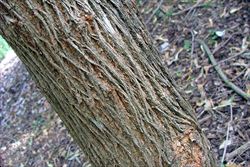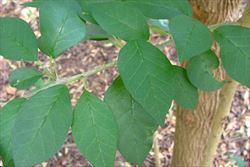Click on images to enlarge

habit (Photo: Sheldon Navie)

furrowed bark on trunk of old tree (Photo: Sheldon Navie)

leaves (Photo: Sheldon Navie)

close-up of leaf and young stem with spines (Photo: Sheldon Navie)

close-up of leaf underside (Photo: Sheldon Navie)

male flower clusters (Photo: Sheldon Navie)

close-up of seeds (Photo: Steve Hurst at USDA PLANTS Database)
Scientific Name
Maclura pomifera (Raf.) C.K. Schneid.
Family
Moraceae
Common Names
bow wood, bow-wood, bowwood, hedge ball, hedge-apple, horse-apple, maclura, mock orange, Osage orange, Osage-apple, tennis ball tree
Origin
Native to some parts of the USA (i.e. Oklahoma, Arkansas, north-western Louisiana and Texas).
Naturalised Distribution
Naturalised in many parts of eastern Australia (i.e. in south-eastern Queensland, many parts of eastern New South Wales and northern Victoria). Also naturalised beyond its native range in the USA.
Notes
Osage orange (Maclura pomifera) is regarded as an environmental weed in New South Wales. This species was widely planted as a hedge plant in the early years of settlement. It has spread from these plantings and become naturalised around settlements in eastern Australia.
While it is generally not considered to be a problem in coastal districts, Osage orange (Maclura pomifera) is becoming invasive in the sub-coastal and inland regions of New South Wales. For example, it is spreading along various watercourses near Inverell in inland northern New South Wales. This species is infesting riparian vegetation and inhibiting the establishment and growth of native vegetation along the McIntyre River. It is also listed as an environmental weed of riparian areas in the Namoi Catchment and as a weed species requiring active control measures in Kwiambal National Park.

